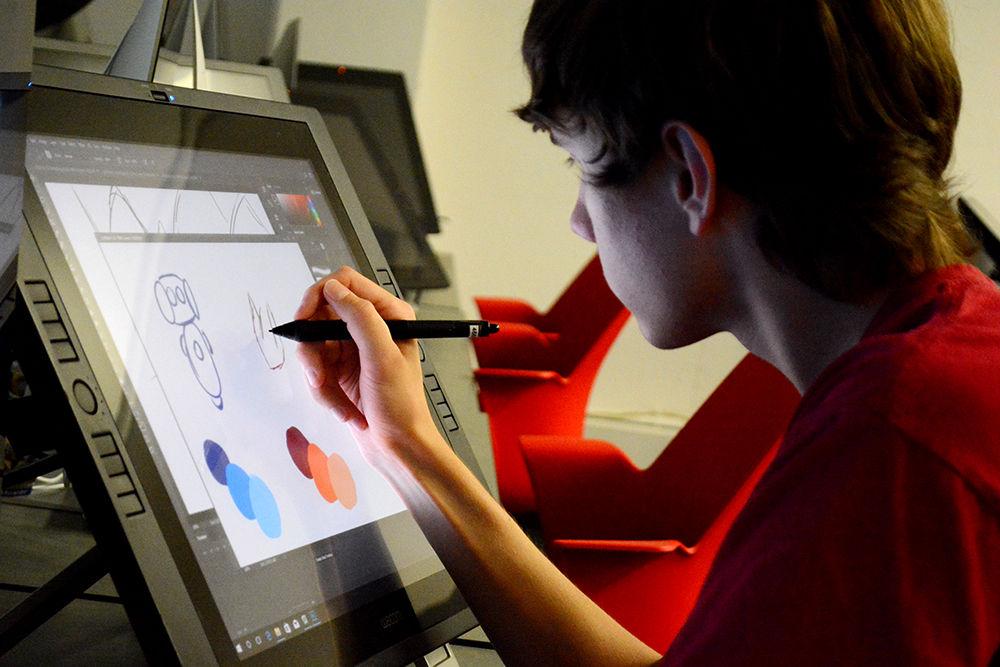 Cameron Martin, a third-year design studies student, selects colors from a palette during the Animation Academia club meeting on Oct. 4 in Brooks Hall. During the meeting, club members learned how to use Adobe Photoshop to create animations, which were then presented at the end on the meeting." />
Cameron Martin, a third-year design studies student, selects colors from a palette during the Animation Academia club meeting on Oct. 4 in Brooks Hall. During the meeting, club members learned how to use Adobe Photoshop to create animations, which were then presented at the end on the meeting." />
Sindy Huang
Cameron Martin, a third-year design studies student, selects colors from a palette during the Animation Academia club meeting on Oct. 4 in Brooks Hall. During the meeting, club members learned how to use Adobe Photoshop to create animations, which were then presented at the end on the meeting.
Those passing through the College of Design’s Brooks Hall will be met with an unforgettable hallway flanked with sketches and portraits of various human faces, poses and appendages, generally highlighting points of motion and interaction. A number of abstract geometric lattices and shapes, structured landscapes and floor plans, and occasional bursts of eye-capturing flora add to the mix. Also tacked to the walls are ring-bound sketchbooks, loaded to the brim with countless artistic experimentations. In some cases, however, when an idea cannot be bound by the motionlessness of the sketchpad, animation takes the extra step in bringing that idea to life. Animation Academia, an on-campus organization here at NC State, is where students can make all of that and more happen.
To be clear, Animation Academia is by no means a traditional “class.” In fact, at the beginning of their most recent meeting, club president Thomas Huneycutt, a fourth-year studying art and design, avoided giving the impression of a teacher walking students through a lesson; student club members concentrating in animation already get enough of that from their courses, anyway.
“For me, if there’s people who enjoy animation, then that’s what this club is for,” Huneycutt said. “Once I get that out of the way and people know how to use Photoshop or Flash, then I hope to dive into animation principles or just animation techniques, which is where I think the really fun part of the club can be.”
The primary focus of this club is to provide students with an environment full of cooperative learning and artistic expression. Through collaboratively indulging in a mutual interest, club members and guest attendees can influence each other’s styles and skills, bounce ideas off of one another as well as offer up insightful tips and pointers. Additionally, club meetings serve as catalysts for idea cultivation and for bringing those ideas to life through digital animation.
The group’s last meeting was centered around an introduction to the basic principles of animating with Adobe Photoshop. Despite a low turnout, an expected consequence of being a newly founded club, Animation Academia attracted the kind of members it needed for an interesting session. After a quick rundown of how to get started, club attendees animated and presented their own stick figure-themed GIFs, with a few out of the box exceptions.
According to Huneycutt, a group of fourth-years had started an animation club last year, with a more professional, illustration-focused direction. After the aforementioned students graduated, and their club inevitably came to an end, the animation community on campus was left with a void that needed filling. Animation Academia seeks to cover the wider range of animation principles, styles, techniques and applications, and strives to be more community-based than its predecessor.
While not explicitly against the idea of hosting events, Huneycutt mentioned that he and the other club officers unanimously decided on a less event-fueled agenda for the club’s direction. The goal is to build more of a foundation centered on a shared passion and interest in animation. In short, they want people to join the club for what it is.
“People wouldn’t want to stay [in the club] if they came for an event,” Huneycutt said. “If I wanted people to stay in the club, it would be because this is a club worth coming to on a regular basis.”
A consistently mentioned mindset amongst members was the intense level of mental dedication that the fundamental animation process requires.
“You have to be a little insane,” said Cameron Martin, a third-year studying design. “You’re drawing the same thing over and over again.”
Martin described the process as extremely tedious, despite mild tweaks here and there between frames. This is done to create the illusion of movement and progression, which ultimately feeds into the rewarding aspect of a complete animation project.
The meeting progressed as members with focused faces engaged in a flurry of idea carving, digital sketching and frame manipulation. Each animator leaned toward their own observably unique style, which speaks to the broad range of expression animation can deliver.
“That’s the essence of animation, using motion to express things,” Huneycutt said. “There is a lot that animation can expand into.”